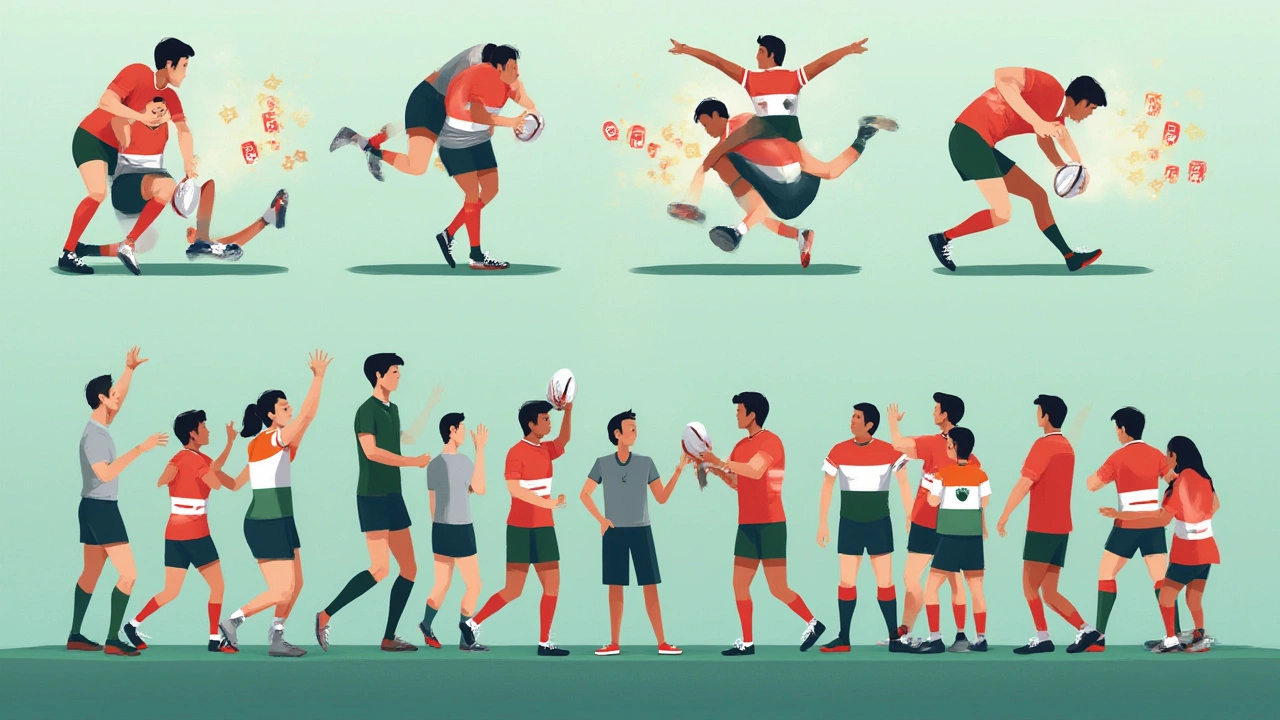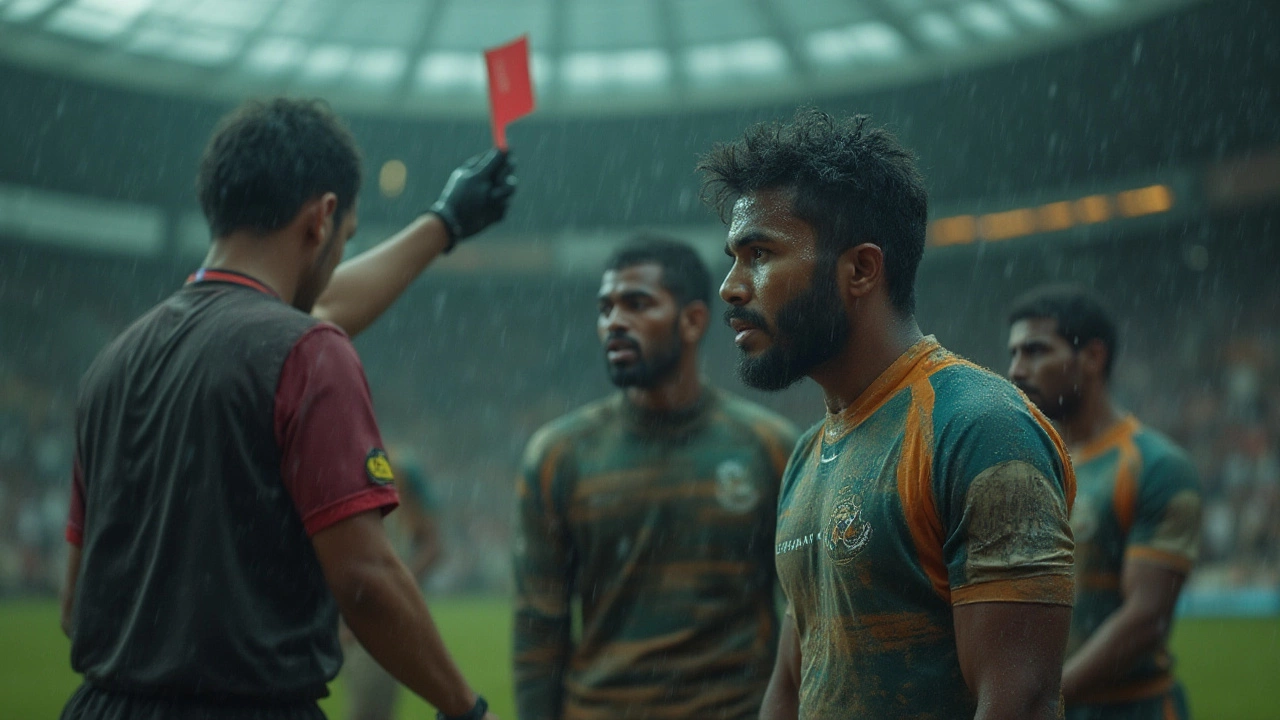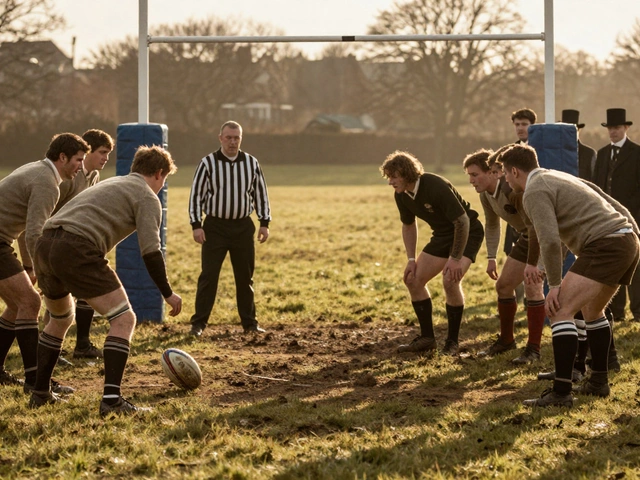Ever watched a rugby match and wondered why the referee suddenly blasts his whistle and everyone stops? Sometimes it feels like players are smashing into each other with no rules at all, but rugby is actually packed with strict do’s and don’ts. What’s not allowed in rugby can sometimes be the difference between glory and a long walk off the pitch. Let’s break down the banned moves, the dangers, and exactly what’ll get you in hot water so you can follow—or play—the game without getting on the wrong side of the laws.
Illegal Tackles and Dangerous Play
Rugby is built around tackling, but not just any hit goes. The most obvious red flag is a high tackle: you can never grab or hit someone above the line of their shoulders. Anything near the neck is out, no matter how tempting it is in the heat of the game. A recent World Rugby report said high tackles have dropped by almost 30% since stricter clampdowns began in 2019, but even with that, one or two offenders are still carded every match.
Another thing: tackling someone who’s off their feet is a massive no-no. Once a player’s on the ground, they’re out of the play, and driving into a ruck recklessly can cause injuries all around. You’re not allowed to tip, spear, or dump-tackle someone so they land on their head or neck. Saw some of these in old matches? Yep, carded every time under current rules.
Lifting legs in a maul or lining up a player with a late hit? Both are straight up penalties at best, yellow or even red cards at worst. Then there’s the stuff that looks silly on TV but is dangerous in real life—no grabbing hair, no tripping, biting, punching, or eye-gouging (sadly, eye injuries still happen every season). You’re also not allowed to use your elbow or knee to strike out while running or tackling. Referees today have access to TMO replay technology, so if you think you got away with something, think again—it’s likely to be reviewed.
Let’s talk about scrums and lineouts. Front row players have to engage safely, wait for referee’s call, and never collapse a scrum on purpose—it’s a big risk for everyone’s neck and spine. Lifting in a lineout is allowed, but if you purposely drop a player once they’ve left the ground, expect a penalty and a chat with the match official. When it comes to dangerous play, the risk isn’t just a penalty: a 2023 study from the University of Bath found that over 60% of serious injuries in community rugby came from illegal tackles or poor technique.
Offside and Obstruction
The offside law in rugby is the silent killer of many a great move; you step a toe past the last foot in a ruck, you’re out of play. At a quick ruck or maul, it’s tempting to go for the ball early, but if your body isn’t behind the back foot, penalty time. Wingers and scrum-halves especially trip up on this one, and a quick whistle can mean turning over possession and momentum.
Obstruction pops up all the time, especially when teams use decoy runners. If you run in front of the ball carrier to block a tackler, you’ve just committed a penalty. Rugby relies on fairness—even accidental screens or blocking can get pinged if it prevents an opponent from making a play. You’ll often hear spectators groan about “shepherding” or “crossing” when runners get in the way, and the ref spots those more than you’d think. The phrase to know? “You must not impede an opponent who does not have the ball.”
There’s also accidental offside. If you or your teammate kick the ball forward and it bounces into someone ahead of the kicker, the play stops and the ball usually goes to the other side. Little errors, big consequences. It can be maddening—one moment everyone’s lining up for a try, next thing you’re retreating 10 meters for a simple mistake.
| Rugby Violation | Description | Common Outcome |
|---|---|---|
| High tackle | Contact above shoulders | Penalty, yellow card or red card |
| Obstruction | Blocking a defender | Penalty |
| Offside | Being ahead of the last foot at rucks/mauls | Penalty, loss of possession |
| Tip tackle | Lifting and turning a player so they land on head/neck | Penalty, red card |
| Collapsing scrum | Bringing scrum down deliberately | Penalty, risk of sanction |
| Punching/biting | Physical foul play | Penalty, yellow or red card |
The offside and obstruction rules are the backbone of keeping the game flowing smoothly, but when teams are tired or desperate, mistakes slip in all the time. That’s why every coach, right from the school level, drills these basics over and over: small lapses can swing big games.

What’s Not Allowed at the Breakdown
The breakdown—the chaotic moment after a tackle, when players try to win or protect the ball—is where most infringements happen. Piling in from the side instead of ‘the gate’ (straight behind the tackled player), not releasing the ball, or holding onto a tackler? All illegal, all punishable by penalty.
If you’re defending, you must release the tackled player and then roll away. If you’re the tackled player, you have to release the ball right away—no stalling, no trying to shift it sneakily to a teammate. Referees these days are strict; in big tournaments like the 2024 Rugby Championship, there were over 19 penalties per game just for breakdown offences, according to official stats.
Players also get in trouble for “sealing off”: lying on top of the ball to shield it from competition. Most fans don’t notice these fouls, but referees watch for those dead-time moments when someone selfishly blocks the contest. Then there’s the “hands in the ruck”—once the ruck is formed, no one (except the scrum-half under specific rules) can pick the ball out.
- Entering from the side of a ruck or maul
- Not releasing ball or player after tackle
- Hands in the ruck after it’s formed
- “Sealing off” with the body over ball
- Kicking another player while contesting at the breakdown
Slowing the ball down illegally annoys players and fans more than almost anything else. Fast, clean ball makes for a thrilling spectacle, and breakdown cheats can wreck that. If you watch enough professional games, you’ll see world-class players binned (sent off for 10 minutes) for those sneaky breakdown fouls, especially if the ref has already given a warning.
Foul Play, Unsportsmanlike Conduct, and Dissent
Rugby builds itself around respect: for the ref, for other players, and for the game. There’s no room for dangerous retaliation, sly trips, or sly punches—these all attract harsh penalties, and players can be banned from multiple matches depending on the severity. Using foul language towards the official or even just arguing a decision is off limits. Ask any schoolboy in India or pros in New Zealand—the ref’s authority is hardcoded.
Deliberate knock-ons (batting the ball forward instead of trying to catch), diving, faking an injury to get a penalty—no chance of fooling anyone in modern rugby. Video replays in major leagues pick up just about everything. Persistent offending (even tiny fouls) from the same player or team also racks up penalties and can see a player sent off. According to RugbyPass, the top leagues handed out 312 yellow cards in the 2023/24 season—almost half for repeat team offences like slowing the ball or constant offside.
Then there’s dissent. Pretty much the polar opposite of cricket where players argue politely; rugby expects silence apart from the captain. Ignore it, and you’ll pay with territory or even a march to the sin bin. Coaches in Mumbai’s youth leagues actually teach hand signals for captains to talk to refs, and a few quiet words go a long way compared to shouting. The same goes for fans—no running on the pitch, no laser pens, or abuse from the sidelines, or the game can be stopped.
Any deliberate attempt to cheat, whether it’s messing with someone’s boot laces or tampering with the ball (yes, it’s happened), will get you more than just a ticking off. Suspensions, fines, or lifetime bans have been given for extreme unsportsmanlike conduct, and officials in India now require annual code-of-conduct meetings for club players just to keep things tight.

Equipment, Etiquette, and Other Banned Behaviors
Wearing jewelry, hard objects, or boots with illegal studs isn’t allowed. Referees inspect players—sometimes twice—before they’re allowed on. You’ll see players wiggling their hands to show they’re not hiding anything. No pockets, zips, or clothing that can snag. If your shirt tears in a tackle, you have to switch it immediately. Even things like headgear or protective padding must meet World Rugby standards—no sneaky armor allowed.
Here’s a wild fact: in some leagues, using tape incorrectly (like wrapping fingers together) can see you pulled from the field. The logic is simple—anything that gives you an unnatural advantage or risks another’s safety is out. Gumshields (mouthguards) aren’t always mandatory in smaller club games in India, but at the top level they’re a non-negotiable. If you get caught wearing boots with metal blades instead of proper studs, you’re out and your team could lose points.
Prematch etiquette is important too. No charging at the opposition during the anthems or haka. There’s a line drawn, and crossing onto your opponent’s half before the whistle is forbidden. When tempers flare—maybe after a late hit or a clash at the ruck—players are expected to step back when told. Arguing with touch judges (the assistant referees) or ignoring protocol can land a player in deep trouble.
Rugby also frowns on fake injuries to win a time-out, and you can’t feign blood to trigger a substitution. Referees will stop the game for legitimate injuries, but if you put on an act, there’s a fair chance you’ll be cited after the match. Even coaches can get banned if found giving instructions from anywhere but their allowed area or communicating illegally with players mid-game using tech (yes, they check!).
Staying in the spirit of the game is what rugby prides itself on. That means not arguing, not cheating with the kit, and not seeking dodgy ways to get ahead. If you break the laws, expect to pay the price—and there’s always another ref watching, even in backyard games like the ones I’ve tried with my dog Max as an unwilling winger. Play fair and you’ll never have to worry about what’s not allowed; overstep just once, and you’ll find out quick how strict rugby can be.





